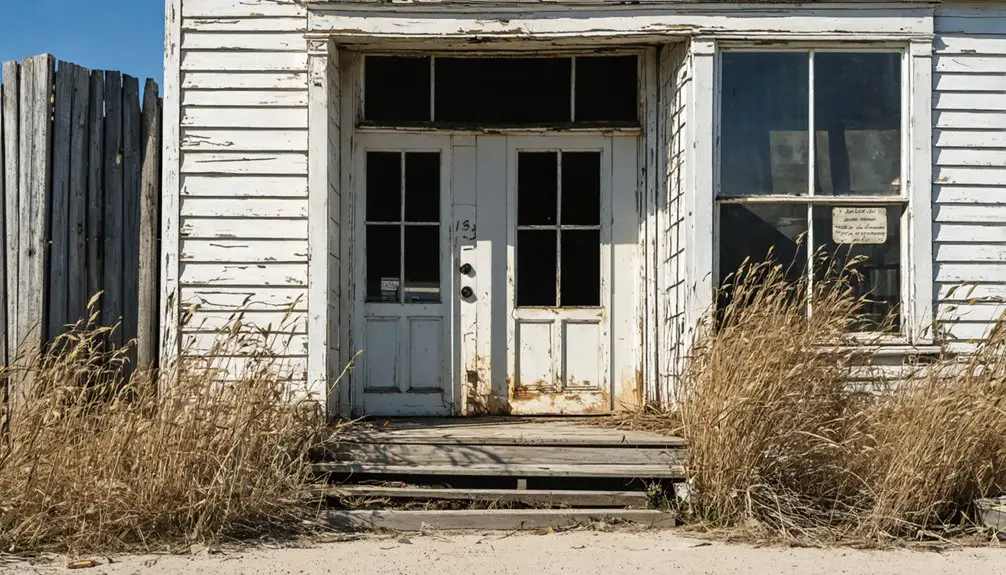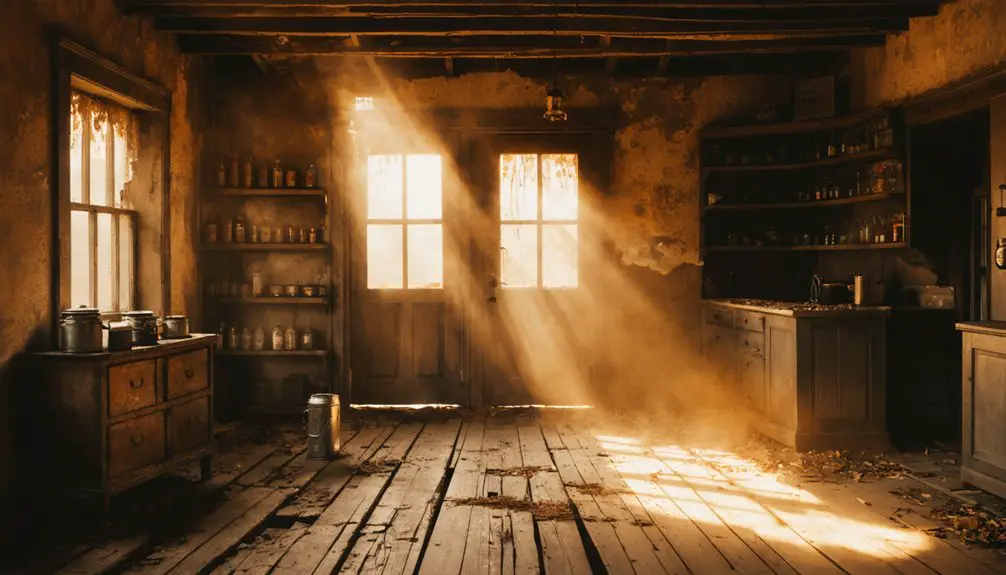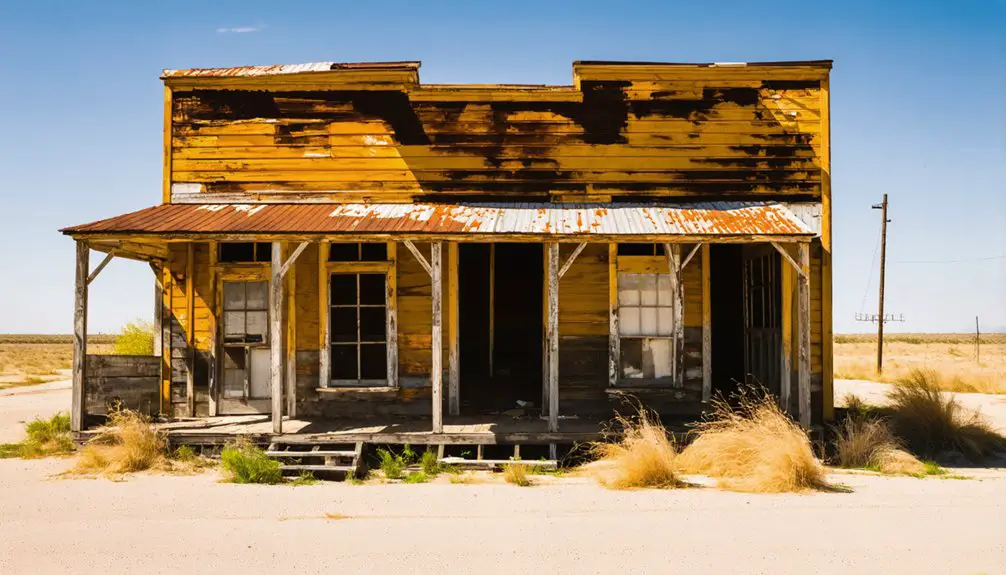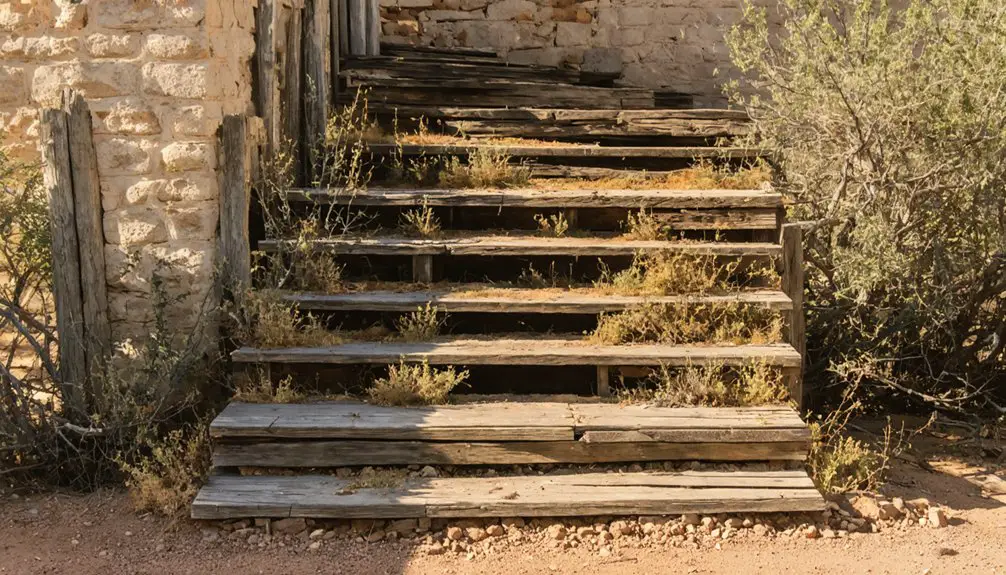You’ll find Audra’s ghost town remains two miles from present-day Bradshaw, Texas. Founded in 1900 by C. Meno Hunt, Fred Robinson, and Frank Sheppard, this frontier settlement reached 75 residents by 1905. When the Santa Fe Railroad bypassed Audra in 1909, the entire population relocated to establish Bradshaw near the tracks. Today, only a cemetery and building foundations mark where this once-thriving community stood. The full story of Audra’s brief but fascinating existence reveals surprising historical details.
Key Takeaways
- Audra was established around 1900 by C. Meno Hunt, Fred Robinson, and Frank Sheppard, named after Sheppard’s daughter.
- The town reached its peak population of 75 residents in 1905, centered around a general store.
- In 1909, the Santa Fe Railroad bypassed Audra by two miles, leading to the town’s complete abandonment.
- Residents relocated to establish Bradshaw near the railroad, moving all buildings and businesses from Audra.
- Today, only a cemetery and remnants of cinnabar mining operations remain at the original Audra site.
The Birth of a Community
When three enterprising friends – C. Meno Hunt, Fred Robinson, and Frank Sheppard – pooled their entrepreneurial spirit to establish Audra around 1900, you’d have witnessed the birth of a promising Texas settlement.
Their vision centered on a strategic general store that would become the heart of local commerce and community dynamics.
Similar to the town of Aurora, which experienced a scattered settlement pattern in its early days, the store wasn’t just a business – it served as the town’s social hub and lifeline, providing essential supplies to the growing population.
As residents settled in the Taylor County location, the community grew to about 75 people by 1905.
You’ll recognize how the founding trio’s business acumen shaped Audra’s early development, creating a self-sustaining marketplace that anchored the rural settlement’s daily life and trade activities.
Unlike Audra State Park in West Virginia, this Texas settlement was primarily focused on commerce rather than recreation.
Origins Behind the Name
You’ll find the story behind Audra’s name in Frank Sheppard‘s family, as he chose to honor his daughter when establishing the town around 1900.
As one of three founding partners who opened the settlement’s first general store, Sheppard followed a common Texas practice of the era by giving the new community his daughter’s name.
Like the ghost town of Thurber, which once had black diamonds beneath its soil, Audra too would face uncertain times ahead.
The personal choice of “Audra” helped distinguish this Taylor County settlement from other nearby towns while reflecting the close family ties typical of early Texas communities. This approach differed from towns like Ayr, which took its name from a Scottish town rather than local connections.
Named For Sheppard’s Daughter
The origins of Audra’s name trace back to Frank Sheppard’s eldest daughter, Audra Sheppard, reflecting a common tradition in early 1900s Texas of naming settlements after family members.
You’ll find the Sheppard family’s legacy deeply woven into the town’s identity, as Frank Sheppard played a pivotal role in establishing the community’s commercial foundation through his partnership in the local general store.
The naming choice strengthened community identity and followed the era’s practice of founders leaving their mark through family names on regional maps.
More recently, another Audra Sheppard became part of Taylor County’s history when she married Jim Sheppard in 1972, continuing the family name’s presence in the region.
While Audra’s existence was brief, ending around 1909 when the railroad bypassed the settlement, the name continues to preserve the Sheppard family’s historical presence in Taylor County, connecting local history to personal stories rather than geographical features.
The town’s final chapter closed when the Post Office relocated to nearby Bradshaw on November 19, 1909, marking the end of Audra’s official status as an independent community.
Early 1900s Town Identity
Three pioneering friends – C. Meno Hunt, Fred Robinson, and Frank Sheppard – established Audra around 1900, creating a vibrant community centered on their general store.
You’ll find their legacy reflected in the early town’s cultural footprint, which grew to about 75 residents by 1905.
The town’s community dynamics revolved around:
- A strategically placed general store serving as the social hub
- Agricultural trade supporting local settlers’ needs
- Strong family-centered relationships among residents
- Regular gatherings that reinforced community bonds
Like many company towns of that era, Audra maintained strict labor control through limited access and supervision of its workers.
Located 2.5 miles west of future Bradshaw, Audra’s position initially seemed promising. Like the town of Plemons Crossing, Audra’s early success was tied to its strategic location.
However, when the railroad bypassed the settlement in 1909, building tracks two miles east, the town’s fate was sealed.
Most residents relocated to the new railroad town of Bradshaw, transforming Audra into the ghost town you can explore today.
Life in Early Audra
During its peak around 1905, Audra flourished as a close-knit community of roughly 75 residents, with influential founders C. Meno Hunt, Fred Robinson, and Frank Sheppard leading the way.
You’d find most families living in simple wooden homes clustered around the general store, which served as the town’s lifeline for supplies and social interaction.
Community dynamics revolved around shared experiences of frontier living. You’d see neighbors trading goods, sharing news, and helping each other through daily hardships.
Most residents earned their living through small-scale agriculture or local trade, while relying heavily on the general store for essential goods.
Without formal institutions, families created their own entertainment through outdoor activities and informal gatherings, building a resilient pioneer spirit that defined early Audra life.
The Railroad’s Impact
When Santa Fe Railroad constructed its line two miles east of Audra in 1909, it sealed the town’s fate. The railroad expansion bypassed Audra completely, triggering a swift economic decline that would transform the settlement into a ghost town.
You’ll find the impact was devastating and irreversible, as residents and businesses made the practical choice to move. Here’s what happened:
- The entire population of 75 relocated eastward to establish Bradshaw.
- All businesses, including the general store, moved to maintain rail access.
- The post office officially transferred to Bradshaw on November 19, 1909.
- Audra became completely abandoned within months.
The Baptists and Methodists shared a church in the original town before the mass exodus occurred. The town’s story reflects a common pattern across Texas, where railroad routing decisions determined which communities would thrive and which would disappear into history.
Relocation to Bradshaw

When the Atchison, Topeka and Santa Fe Railway bypassed Audra by two miles in 1909, you’d find the entire population choosing to relocate closer to this essential transportation link.
You’ll see the community physically moving their buildings, businesses, and institutions eastward to establish the new town of Bradshaw along the railroad line. The name Bradshaw became so widely used that it required place name disambiguation to distinguish it from other similarly named locations.
Railroad Drives Town Move
As the Atchison, Topeka and Santa Fe Railway constructed its extension line two miles east of Audra in 1909, the town faced a critical turning point.
The railroad’s significance for economic survival forced residents to make a bold choice – relocate or risk their town’s future.
The railroad’s impact on Audra led to these decisive changes:
- Entire population physically moved their buildings and homes to the railroad line
- New settlement named Bradshaw established after local pioneer family
- Post office officially transferred on November 19, 1909
- School district relocated and renamed to reflect new identity
You’ll find that Bradshaw quickly thrived with its rail connectivity, while Audra faded into ghost town status.
The move proved crucial, as the railroad provided essential passenger service, freight transport, and access to wider Texas markets that weren’t possible at the original location.
Population Shifts East
Following the railroad’s eastward construction in 1909, Audra’s entire population of 75 residents set out on a transformative two-mile migration to establish the new town of Bradshaw.
You’ll find the population migration was driven by residents’ desire to capitalize on economic opportunities presented by the Abilene & Southern Railroad line.
The shift brought immediate changes, as the post office relocated on November 19, 1909, and a new three-room brick school replaced the old Audra facility.
Bradshaw’s population surged to 450 by 1929, dwarfing Audra’s original numbers.
The ghost town you’ll see at Audra’s original site today, marked by the nearby Bradshaw Cemetery, stands as evidence to how railroad access could make or break a frontier settlement’s survival.
Business District Relocates
Because the Abilene & Southern Railroad bypassed Audra by two miles in 1909, the town’s business district faced an essential decision to survive.
The business dynamics forced merchants to evaluate moving operations to the newly established town of Bradshaw along the railroad line. The economic shifts were swift and decisive.
Here’s what happened when Audra’s commercial heart relocated to Bradshaw:
- Store owners dismantled their businesses and rebuilt them along the rail line
- The post office officially transferred to Bradshaw on November 19, 1909
- Families followed the business district’s move to maintain their livelihoods
- Bradshaw quickly emerged as the area’s new economic hub
The relocation proved important for business survival, as rail access provided critical supply chain connections and market opportunities that weren’t possible in isolated Audra.
Historic Buildings and Landmarks

While the remnants of Audra’s cinnabar mining operations paint a vivid picture of its industrial past, the town’s historic buildings and landmarks tell a broader story of community life.
You’ll find historic structures scattered throughout the landscape, from stone foundations of miners’ homes to partially standing commercial buildings that once served as general stores and tool sheds. The architectural styles reflect the practical needs of a frontier mining community, with local stone and wood being the primary building materials.
The three-story house stands as the town’s best-preserved residence, complete with original furnishings.
Standing tall among Audra’s ruins, the three-story residence remains frozen in time, its rooms still furnished as residents left them.
Meanwhile, the cemetery serves as a poignant reminder of the community’s struggles, featuring handwritten gravestones that document the lives of early settlers.
Industrial remnants, including processing mills and equipment sheds, round out Audra’s architectural legacy.
Notable Families and Pioneers
As three pioneering friends laid the foundation for Audra in 1900, C. Meno Hunt, Fred Robinson, and Frank Sheppard established the town’s first general store. Their pioneer contributions shaped the community’s early development, with the town itself named after Sheppard’s daughter.
When the railroad bypassed Audra in 1909, these founding families led the way to establish Bradshaw just two miles east.
Here’s how their family legacies continued:
- The Sheppard family maintained prominence with descendants settling near Bradshaw.
- Opal Hunt, C. Meno’s daughter, operated the Audra Mercantile in Bradshaw.
- The Knaus family connected with Dave Bradshaw through marriage.
- The McClaslands became significant landholders outside Bradshaw.
These pioneer families’ influence extended through commerce, agriculture, and community leadership well into the 20th century.
From Bustling Town to Abandonment

Though Audra started promisingly in 1900 with a general store and growing population of 75 residents, the town’s fate changed dramatically when railroad construction bypassed it in 1909.
The town’s community dynamics centered around the general store, which served as both a commercial hub and social gathering place for the small settlement.
When the railroad was built closer to what would become Bradshaw, Audra’s economic sustainability quickly crumbled.
Rather than trying to secure their own station, the residents made a collective decision to relocate.
In a coordinated move, they abandoned their homes and businesses, establishing the new town of Bradshaw to capitalize on the railroad’s opportunities.
Present-Day Legacy and Historical Significance
Despite its complete abandonment in 1909, Audra’s legacy endures through its remaining general store building and historical significance in Taylor County’s development.
Though Audra’s streets fell silent in 1909, its general store still stands as a testament to Taylor County’s pioneering spirit.
Today, you’ll find Audra among Texas’s 500+ ghost towns, contributing to the state’s rich historical preservation efforts and ghost town tourism appeal.
The town’s lasting impact can be traced through:
- The original Sheppard general store building, which stands as the sole maintained structure
- Its role in Bradshaw’s establishment, showcasing how railroad-driven migration shaped Texas communities
- The preserved foundations and remnants that tell the story of early 20th-century rural life
- Its educational value in demonstrating how transportation infrastructure influenced settlement patterns
Located 2.5 miles west of Bradshaw near the cemetery, Audra serves as a reflection of Texas’s dynamic settlement history.
Frequently Asked Questions
What Was the Population of Audra at Its Peak?
You’ll find Audra’s population trends reached their historical significance in 1905 with 75 residents at its peak, when the town supported two stores, a post office, church, and school.
Are There Any Remaining Foundations or Ruins at the Original Site?
Ever wondered what’s left of old ghost towns? You won’t find much in foundation remnants or ruins at the original site – just one maintained general store building, while ruin exploration reveals mostly barren land.
Did Any Native American Tribes Previously Inhabit the Audra Area?
You’ll find rich Native American tribal history in this area, where Caddo, Alabama-Coushatta, Shawnee, and Delaware peoples lived, farmed, and traded before being displaced by European settlers and Texas Rangers.
What Natural Disasters or Significant Weather Events Affected Audra?
You’d expect dramatic flood impacts or storm damage in Audra’s story, but there’s no evidence of any major natural disasters affecting the town during its brief 1900-1909 existence.
Were There Any Documented Criminal Activities or Lawlessness in Audra?
You won’t find documented criminal activities or lawlessness in Audra’s crime history. The town’s brief existence and small population suggest minimal need for formal law enforcement during its settlement years.
References
- https://sites.rootsweb.com/~txtaylor/communities.htm
- https://kids.kiddle.co/Audra
- https://en.wikipedia.org/wiki/List_of_ghost_towns_in_Texas
- https://www.tshaonline.org/handbook/entries/audra-tx
- https://texashighways.com/travel-news/5-of-the-most-haunted-locations-in-texas/
- https://allacrosstexas.com/texas-ghost-town.php?city=Bradshaw
- https://discovertexasoutdoors.com/places/audra/
- https://www.texasescapes.com/TexasTowns/Bradshaw-Texas.htm
- https://en.wikipedia.org/wiki/Audra
- https://www.tshaonline.org/handbook/entries/aurora-tx-jefferson-county



